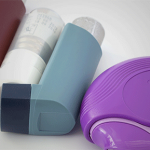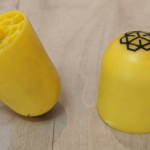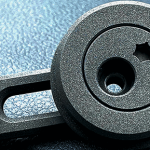- Home
- 3D Printing
- Is metal 3D printing right for my part?
Is metal 3D printing right for my part?
From time to time, customers ask whether we offer metal 3D printing of prototype parts. They are usually already aware of our capabilities in 3D printed plastic parts, CNC machining, laser cutting, vacuum casting and model making, but maybe they have designed a part that they think is a candidate for 3D printing in metal.
The simple answer is no, we do not currently have in-house metal 3D printing, but the topic warrants further exploration.
What are the benefits of metal 3D printing?
We frequently sing the praises of 3D printing for plastic parts because we have a deep understanding of this technology’s benefits. Likewise, metal 3D printing offers huge advantages in some circumstances, whether in prototyping and production. For example, 3D printing can produce ultra-lightweight metal parts that are optimised to provide the required strength and stiffness. Furthermore, 3D printed parts can be truly customised to be a perfect match for individual people.
At the time of writing, the 2022 Beijing Winter Olympics are underway. In the 2018 Winter Olympics we saw speed skaters wearing gloves with metal 3D printed customised tips, and biathlon (cross-country skiing and rifle shooting) competitors using rifles with metal 3D printed grips. The chances are, more use is being made of metal 3D printed parts in the current Winter Olympics and Paralympics.
What is metal 3D printing?
First of all, metal 3D printing is not a single technology, in the same way that plastic 3D printing is not (we have five different technologies in-house). Generally speaking, metal 3D printing machines can be categorised as below. Most are available from multiple manufacturers, albeit with variations in the technologies and part production processes.
- Fused deposition modelling (FDM) – these printers mostly use a filament comprising a metal powder core within a plastic carrier.
- Laser powder bed fusion (LPBF) – as the name suggests, these printers utilise a laser to selectively fuse powder to the build layer beneath. The term is often used interchangeably with direct metal laser sintering (DMLS) and laser metal fusion (LMF).
- Electron beam manufacturing (EBM) – this technology is similar to LPBF but uses an electron beam in place of the laser.
- Laser metal deposition (LMD) – this technology, sometimes called melt deposition, uses a laser to form a melt pool on the metal substrate, into which a metal powder is fed.
- Directed energy deposition (DED) – this type of printer uses a laser, electron beam or plasma to provide the heat input. The feedstock, which can be powder or wire, is fed to the point where the heat energy is being applied. Other terms used for this process are laser engineered net shaping (LENS), direct metal deposition (DMD) and electron beam additive manufacturing (EBAM).
- Binder jetting – 3D printed parts are built by spraying a liquid binder onto a bed of metal powder. The binder is then solidified to build the part in layers.
- Bound powder extrusion – these 3D printers use metal powders bound with waxy polymers. The metal/polymer material is extruded to build the part.
Parts produced with technologies relying on a plastic carrier need to go through a debinding process to remove the plastic, then be sintered to achieve the required strength. Depending on the 3D printing process and application, parts may also require CNC machining, shot peening or sandblasting. In other words, metal 3D printing is not a simple ‘one box’ process.
In total, there are more than a dozen metal 3D printing technologies, with widely varying price tags for the 3D printer. Other post-processing equipment is also necessary, which adds further to the cost. Also, while some machines are described as being office-friendly, others require a dedicated facility.
Is this technology a (3D printed) silver bullet?
We have already hinted that metal 3D printing is an expensive technology and, as with plastic 3D printing, not all processes offer the same accuracy, speed, strength and surface finish. Most processes require metal 3D printed parts to be sintered to ensure the fine particles fuse to each other and provide the best strength possible. However, the sintering leaves microscopic voids and results in part shrinkage – as well as the potential for residual stresses and distortion. Porosity not only reduces part strength but can also cause cracks and poor fatigue performance.
Depending on the type of machine, the 3D printing process might have to be fine-tuned to suit the machine, powder, ratio of virgin-to-recycled powder, and part geometry – all of which relies on the skill and experience of the operative.
Even in a carefully optimised process, metal 3D printed materials can still suffer from anisotropy due to the layer-by-layer build process. This should be taken into account when the designer is optimising the part geometry and the build orientation is being determined.
The final point to note about 3D printing in metal is that it is not quick. First, the part file needs to be processed, ready for the 3D printer, to add support structures, make allowances for shrinkage, and select the build orientation. Then the 3D printing process itself takes time, after which debinding, sintering and finishing operations and processes must be carried out. If the part distorts, it may need to be printed again, using different machine settings or support structures. With our Express 3D printing service for plastic prototype parts, we ship parts the next working day. In contrast, a company 3D printing in metal might quote a turnaround time of 10-15 working days, depending on the material, part geometry and finishing requirements.
Another important issue with metal 3D printing is health and safety. First, metal powders are harmful to health, so precautions must be taken to avoid touching or inhaling the powder. Second, metal powders pose a risk of fire or explosion, so sparks from static electricity or electrical equipment must be prevented.
What are the alternatives to metal 3D printing?
Fortunately, although metal 3D printing is not a silver bullet, there are other prototyping technologies that can usually be used instead. Often when customers ask about metal 3D printing, we find we can CNC machine the part from solid. We may need to agree minor changes to the part geometry but the finished part is often superior, particularly if it is required for a functional prototype. Being machined from solid, the material is isotropic and there is no porosity, so the part is stronger and unlikely to fail prematurely due to fatigue cracking. Another advantage of CNC machining over 3D printing is the far wider choice of metals and alloys.
Our customers are usually working to very tight deadlines, so the speed of CNC machining is a further advantage over metal 3D printing. In addition, CNC machined parts do not suffer from shrinkage and distortion in the same way as 3D printed parts, so the part is almost certain to be ‘right first time’. Our Express service ships parts in three working days and the Standard service ships parts in seven working days.
Todays’ generation of multi-axis machining centres can produce complex 3D profiles. Moreover, we can CNC machine surfaces that have been designed from scratch or generated from 3D-scanned point clouds. Therefore, apart from those geometries that can only be produced by 3D printing – such as three-dimensional meshes – CNC machining can achieve almost anything that metal 3D printing can.
Will Prototype Projects invest in metal 3D printing?
We are not in a hurry to buy a metal 3D printer. If we did, we would need to be sure we were buying the right technology to produce the parts our customers want in terms of size, material, accuracy, speed, porosity and so on. We would also have to invest in a dedicated facility for the metal 3D printer, debinder, sintering furnace and finishing processes. Of course, we would also require highly skilled and experienced operators.
That’s not to say we will never invest in metal 3D printing, as we do not know what the future holds – such as how the technology will develop, or what our customers will require.
What if I really do need a metal 3D printed part?
We have close working relationships with our customers and we pride ourselves on being a one-stop shop for prototyping. We appreciate that metal 3D printing is sometimes the right technology for prototyping. For that reason, we sometimes outsource metal 3D printing to companies that are experts in their field, have top-notch equipment, as well as the knowledge and experience to produce high-quality parts. We are happy to liaise with these specialists so our customers retain a single point of contact for all their prototyping requirements, allowing them to focus on designing and developing tomorrow’s products.
Talk to us
Whatever your prototyping requirements, including metal 3D printing, talk to us on 01763 249760.





